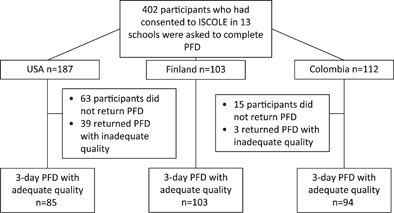International Journal of Obesity Supplements Pub Date : 2015-12-08 , DOI: 10.1038/ijosup.2015.15 T Saloheimo 1 , S A González 2 , M Erkkola 1 , D M Milauskas 3 , J D Meisel 4 , C M Champagne 3 , C Tudor-Locke 5 , O Sarmiento 2 , P T Katzmarzyk 3 , M Fogelholm 1

|
Objective:
The main aim of this study was to assess the reliability and validity of a food frequency questionnaire with 23 food groups (I-FFQ) among a sample of 9–11-year-old children from three different countries that differ on economical development and income distribution, and to assess differences between country sites. Furthermore, we assessed factors associated with I-FFQ’s performance.
Methods:
This was an ancillary study of the International Study of Childhood Obesity, Lifestyle and the Environment. Reliability (n=321) and validity (n=282) components of this study had the same participants. Participation rates were 95% and 70%, respectively. Participants completed two I-FFQs with a mean interval of 4.9 weeks to assess reliability. A 3-day pre-coded food diary (PFD) was used as the reference method in the validity analyses. Wilcoxon signed-rank tests, intraclass correlation coefficients and cross-classifications were used to assess the reliability of I-FFQ. Spearman correlation coefficients, percentage difference and cross-classifications were used to assess the validity of I-FFQ. A logistic regression model was used to assess the relation of selected variables with the estimate of validity. Analyses based on information in the PFDs were performed to assess how participants interpreted food groups.
Results:
Reliability correlation coefficients ranged from 0.37 to 0.78 and gross misclassification for all food groups was <5%. Validity correlation coefficients were below 0.5 for 22/23 food groups, and they differed among country sites. For validity, gross misclassification was <5% for 22/23 food groups. Over- or underestimation did not appear for 19/23 food groups. Logistic regression showed that country of participation and parental education were associated (P⩽0.05) with the validity of I-FFQ. Analyses of children’s interpretation of food groups suggested that the meaning of most food groups was understood by the children.
Conclusion:
I-FFQ is a moderately reliable method and its validity ranged from low to moderate, depending on food group and country site.
中文翻译:

9-11岁儿童短期食物频率问卷的信度和效度:针对三个中等收入和高收入国家的跨国研究
客观的:
本研究的主要目的是评估食物频率调查问卷的信度和效度,该问卷包含 23 个食物组 (I-FFQ),样本来自三个经济发展和收入不同的不同国家的 9-11 岁儿童分布,并评估国家站点之间的差异。此外,我们还评估了与 I-FFQ 性能相关的因素。
方法:
这是国际儿童肥胖、生活方式和环境研究的辅助研究。本研究的可靠性 ( n = 321) 和有效性 ( n = 282) 部分具有相同的参与者。参与率分别为95%和70%。参与者完成了两次 I-FFQ,平均间隔为 4.9 周,以评估可靠性。3 天预编码食物日记 (PFD) 被用作有效性分析的参考方法。Wilcoxon 符号秩检验、组内相关系数和交叉分类用于评估 I-FFQ 的可靠性。Spearman 相关系数、百分比差异和交叉分类用于评估 I-FFQ 的有效性。使用逻辑回归模型来评估所选变量与有效性估计的关系。根据 PFD 中的信息进行分析,以评估参与者如何解释食物组。
结果:
可靠性相关系数范围为 0.37 至 0.78,所有食品组的严重错误分类均 <5%。22/23 食品组的有效性相关系数低于 0.5,并且各个国家/地区的相关系数有所不同。就有效性而言,22/23 食品组的总错误分类<5%。19/23 食物组没有出现高估或低估。Logistic 回归显示,参与国家和家长教育程度与 I-FFQ 的有效性相关(P ≤ 0.05)。对儿童对食物组的解释的分析表明,儿童可以理解大多数食物组的含义。
结论:
I-FFQ 是一种中等可靠性的方法,其有效性范围从低到中等,具体取决于食品类别和国家/地区。


























 京公网安备 11010802027423号
京公网安备 11010802027423号